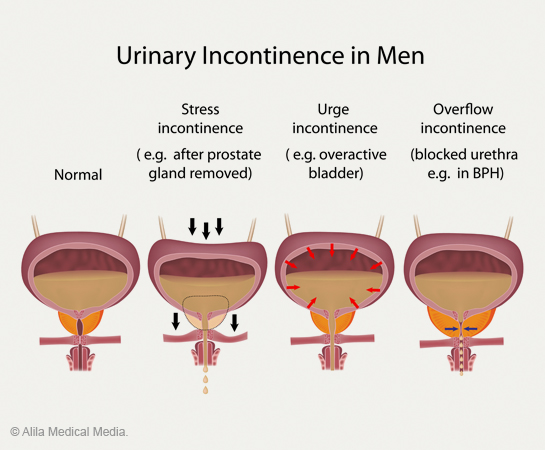Urinary incontinence is the inability to control urination. The term may be used interchangeably with Overactive Bladder (OAB), which also includes the same frequency in urination and urinary urge. People who suffer from overactive bladder, or urinary incontinence, can't hold their urine -- they wet themselves. Leaking urine is normal only in infants; it is not a normal result of aging. If you have this problem, you may be too embarrassed or upset to ask for help. Don't be. It is estimated that over 12 million Americans have urinary incontinence. Incontinence affects all ages, both sexes, and people of every social and economic level. It is also estimated that 15 to 30 percent of people over the age of 60 who live at home have incontinence. Women are twice as likely as men to have this condition. In addition, at least half of the 1.5 million Americans who reside in nursing homes are incontinent. The exact number of people with incontinence is not known, but the total number of people affected may be far greater than current estimates.
Types of Incontinence
Incontinence is classified by the symptoms of or circumstances occurring at the time of urine leakage.
Stress incontinence: May be due to poor bladder support by the pelvic muscles or to a weak or damaged sphincter. This condition allows urine to leak when you do anything that strains or stresses the abdomen, such as coughing, sneezing, laughing, or even walking.
Urge incontinence: Results when an overactive bladder contracts without your wanting it to do so. You may feel as if you can't wait to reach a toilet. At times, you may leak urine without any warning at all. A bladder can become overactive because of infection that irritates the bladder lining. The nerves that normally control the bladder can also be responsible for an overactive bladder. In other cases, the cause may be unclear.
Mixed incontinence: Is often a combination of both conditions above -- stress and urge incontinence.
Overflow incontinence: Occurs when the bladder is allowed to become so full that it simply overflows. This happens when bladder weakness or a blocked urethra prevents normal emptying. An enlarged prostate can result in such blockage. For this reason, overflow incontinence is more common in men that in women. Bladder weakness can develop in both men and women, but it happens most often in people with diabetes, heavy alcohol users, and others with decreased nerve function.
Environmental incontinence (sometimes called functional incontinence): Occurs when people cannot get to the toilet or get a bedpan when they need it. The urinary system may work well, but physical or mental disabilities or other circumstances prevent normal toilet usage.
Nocturnal enuresis Is incontinence that occurs during sleep.
When individuals have two or more types of incontinence, the causes of each must be found and considered in planning appropriate treatment.

What to do about Incontinence?
The first step is to locate a health care provider, such as a urologist, who is interested in and well-informed about treating incontinence. He or she will want to become familiar with your medical history and the way in which incontinence affects you. Be sure to come prepared for your visit with: (1) a list of all the medications you are currently taking, including those you purchase without a prescription; (2) the dates and outcomes of any bladder-related tests or surgical procedures you may have had; and (3) a bladder diary.
If you are seeking products to help with incontinence, click below to visit the Urology Health Store.
